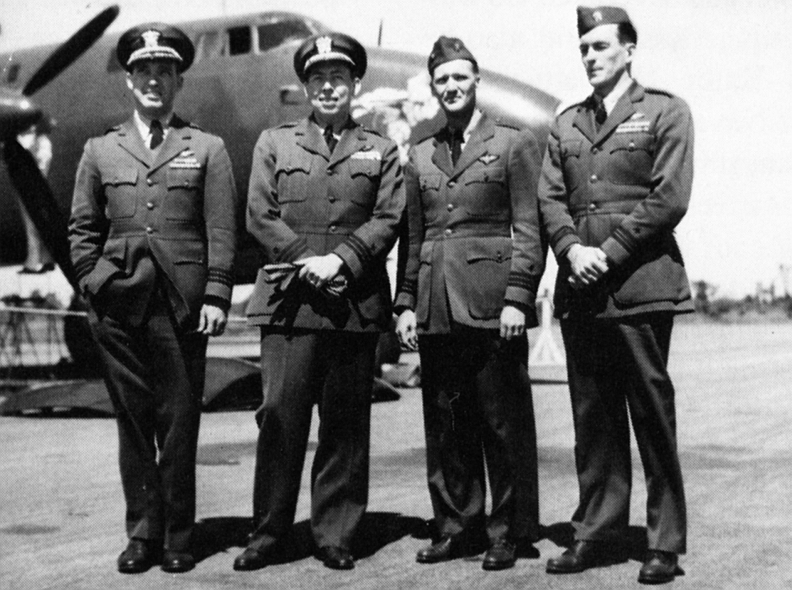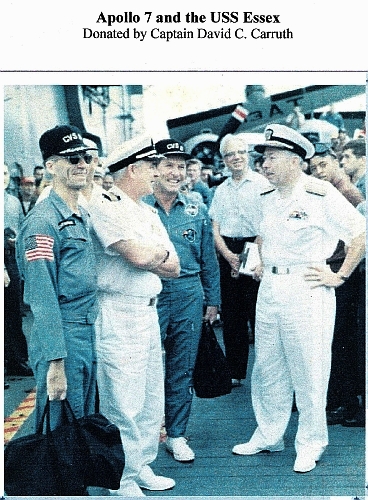In this image from left: CDR Rankin, CDR Davies, CDR Reid, LCDR
Tabeling
As did so many in the military during WWII, CDR Davies rose rapidly through the ranks, having been commissioned from the U.S. Naval Academy in 1937. He served on two cruisers after graduation. He completed flight training late in 1942, and was immediately assigned as Executive Officer of VPB-129, operating against German U-boats off the coast of Brazil. LCDR Davies was awarded the Distinguished Flying Cross after his crew’s direct hit and sinking of a German sub only five years after his Naval Academy graduation. He then commanded a patrol squadron of Brazilian fliers, and wrote an instruction book in Portuguese for the training of his pilots.
After his record-breaking Turtle flight, CDR Davies was one of two pilots who demonstrated the P2V’s ability to take off from an aircraft carrier (the USS Coral Sea) using JATO power augmentation. That demonstration was vital to Navy interests because the Navy’s first planned carrier-based nuclear weapon delivery vehicle was still a year away from production. The carrier launch of P2V’s kept the Navy in the nuclear weapon delivery business, a warfare role that the Air Force wanted for its own.
CAPT Davies served as Commander Fleet Air Wing Three in Brunswick, ME during the Cuban missile crisis. He was the Commanding Officer of NAS Norfolk prior to his selection for flag rank in 1965. As a flag officer, he worked in the Office of the Secretary of Defense, where he created the Office of Program Appraisal (OPA), which oversees all aspects of the Navy’s budgets.
Not many people realize that Tom Davies was a creative and prolific engineer and inventor. A stereoscopic range-finding gun sight that he invented while he was a midshipman at the Naval Academy was adopted and installed on all Navy ships with large caliber guns during WWII. He also designed the first ski-equipped landing gear for use in Antarctic operations. He created novel improvements to navigation sextants to facilitate their use on ships in rough seas. Separately, he created improvements to airborne sextants for use in polar navigation. He also published navigational tables that are still in use today.
RADM Davies retired from the Navy in 1973 to serve in a Presidential appointment as Assistant Director, Arms Control and Disarmament Agency. He passed away in 1991 at the age of 77.
CDR Eugene P. Rankin: CDR Eugene Rankin, a U.S. Naval Academy graduate and classmate of Tom Davies, earned his wings in 1941 and was with a VP squadron in Panama at the outbreak of WWII. In 1943, just two years after earning his wings, he was assigned as Commanding Officer of VP-81, one of the Black Cat Squadrons in the Pacific operating PBY Catalina seaplanes. In 1946, CDR Rankin was assigned to the Armaments Division in BuAer where he was aware of the development of the P2V and discussed with Tom Davies the possibilities of a long-range record setting flight. He was the first to volunteer to be a part of the Turtle crew.
After the Turtle flight, CDR Rankin switched from land-based to carrier-based aviation. He was the CO of VF-1 aboard the USS Midway (CV-41), flying the F4U Corsair. Following a tour at the Naval Academy, he was CO of VC-8, flying the AJ Savage. He served as XO aboard USS Rendova (CVE-112), followed by tours on OPNAV, CINCLANT and CINCPAC staffs. He became the CO of USS Pine Island (AV-12) in 1961, and became the CO of USS Kearsarge (CVS-33) in 1962. During his time on the Kearsarge, that ship participated in NASA’s first-man-in-space program, Project Mercury. In October of 1962, the Kearsarge recovered Wally Schirra and his Sigma 7, and six months later recovered Gordon Cooper and his Faith 7.
Prior to retirement from the Navy in 1967 he served as Chief of Staff, COMFAIR-SANDIEGO and Inspector General ELEVENTH Naval District. As a civilian, he was an executive with Bisset-Berman, a manufacturer of oceanographic instruments, and later a Trust Officer with San Diego Trust & Savings Bank. He was a long-time Commodore of the Coronado Yacht Club before he passed away in 2000.
CDR Walter S. Reid: CDR Reid was also a Naval Academy classmate of Tom Davies and Eugene Rankin. After going through flight training, he served in patrol squadrons in Panama and Bermuda. He commanded aircraft maintenance squadrons in Australia and in Norfolk, VA. His flying experience in Panama, the Caribbean, the South Pacific and Perth helped him in his selection as Engineering Officer on the Turtle crew. After the Turtle flight, CDR Reid was assigned to the Naval Proving Ground, Dahlgren, VA. He retired from the Navy as a Captain and was known to have been a consultant with the U.S. Coast Guard. CDR Reid wrote an excellent account of the Turtle’s flight for Popular Mechanics magazine.
LCDR Roy H. Tabeling: Nothing about LCDR Tabeling can be found in literature or on the Internet. An article in Foundation magazine by Eugene Rankin indicated that Roy Tabeling had first served in a patrol squadron in Panama and then had been a junior officer in VP-81 until 1944 while CDR Rankin was the CO. LCDR Tabeling was awarded the Air Medal for night PBY operations in the Pacific, and a Commendation Medal for rescuing an Army pilot shot down near Bougainville. Unable to land at sea because of a storm, LCDR Tabeling put his PBY down in a Japanese harbor and taxied out to pick up the flier who was clinging to a life raft.
LCDR Tabeling was chosen for the Turtle crew on the basis of his electronics and communications expertise. After the Turtle flight, he was assigned to the Naval Research Laboratory in Washington, D.C. Roy Tabeling retired from the Navy as a Commander and was an engineer with RCA at the Space Center in Florida.

